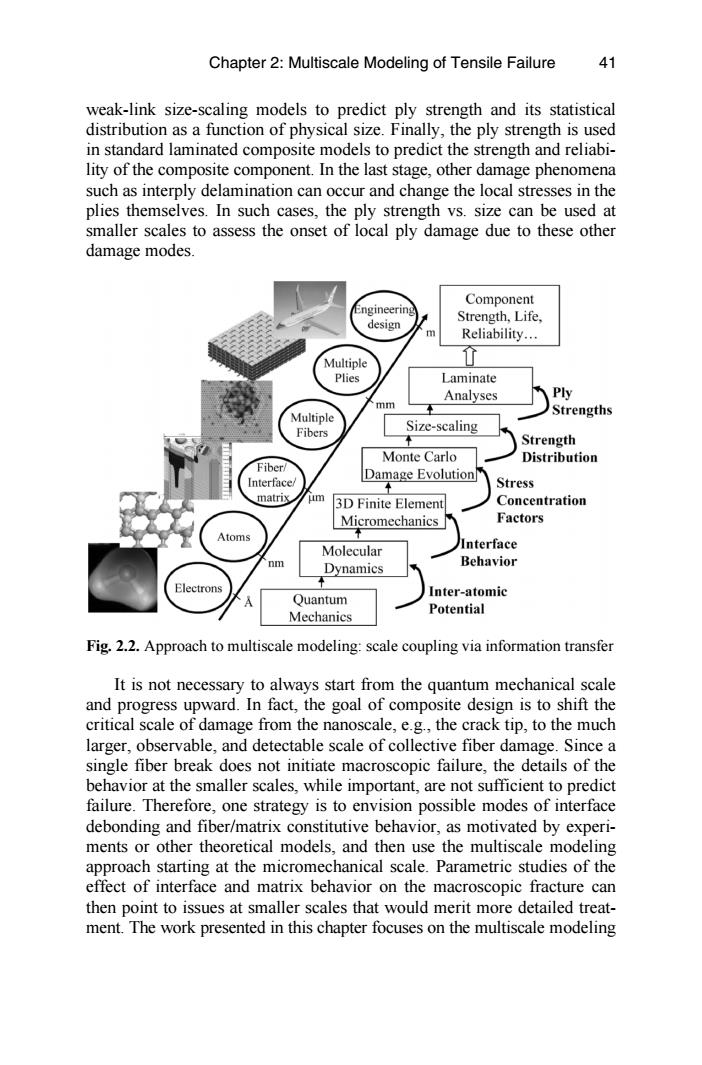正在加载图片...

Chapter 2:Multiscale Modeling of Tensile Failure 41 weak-link size-scaling models to predict ply strength and its statistical distribution as a function of physical size.Finally,the ply strength is used in standard laminated composite models to predict the strength and reliabi- lity of the composite component.In the last stage,other damage phenomena such as interply delamination can occur and change the local stresses in the plies themselves.In such cases,the ply strength vs.size can be used at smaller scales to assess the onset of local ply damage due to these other damage modes. Component Engineering design Strength,Life, m Reliability... Multiple Plies Laminate Analyses Ply mm Multiple Strengths Fibers Size-scaling Strength Monte Carlo Distribution Fiber/ Interface Damage Evolution Stress matrix m 3D Finite Element Concentration Micromechanics Factors Atoms Molecular Interface nm Dynamics Behavior Electrons Inter-atomic Quantum Mechanics Potential Fig.2.2.Approach to multiscale modeling:scale coupling via information transfer It is not necessary to always start from the quantum mechanical scale and progress upward.In fact,the goal of composite design is to shift the critical scale of damage from the nanoscale,e.g.,the crack tip,to the much larger,observable,and detectable scale of collective fiber damage.Since a single fiber break does not initiate macroscopic failure,the details of the behavior at the smaller scales,while important,are not sufficient to predict failure.Therefore,one strategy is to envision possible modes of interface debonding and fiber/matrix constitutive behavior,as motivated by experi- ments or other theoretical models,and then use the multiscale modeling approach starting at the micromechanical scale.Parametric studies of the effect of interface and matrix behavior on the macroscopic fracture can then point to issues at smaller scales that would merit more detailed treat- ment.The work presented in this chapter focuses on the multiscale modelingweak-link size-scaling models to predict ply strength and its statistical distribution as a function of physical size. Finally, the ply strength is used in standard laminated composite models to predict the strength and reliability of the composite component. In the last stage, other damage phenomena such as interply delamination can occur and change the local stresses in the plies themselves. In such cases, the ply strength vs. size can be used at smaller scales to assess the onset of local ply damage due to these other damage modes. Fig. 2.2. Approach to multiscale modeling: scale coupling via information transfer It is not necessary to always start from the quantum mechanical scale and progress upward. In fact, the goal of composite design is to shift the critical scale of damage from the nanoscale, e.g., the crack tip, to the much larger, observable, and detectable scale of collective fiber damage. Since a single fiber break does not initiate macroscopic failure, the details of the behavior at the smaller scales, while important, are not sufficient to predict failure. Therefore, one strategy is to envision possible modes of interface debonding and fiber/matrix constitutive behavior, as motivated by experiments or other theoretical models, and then use the multiscale modeling approach starting at the micromechanical scale. Parametric studies of the effect of interface and matrix behavior on the macroscopic fracture can then point to issues at smaller scales that would merit more detailed treatment. The work presented in this chapter focuses on the multiscale modeling Chapter 2: Multiscale Modeling of Tensile Failure 41